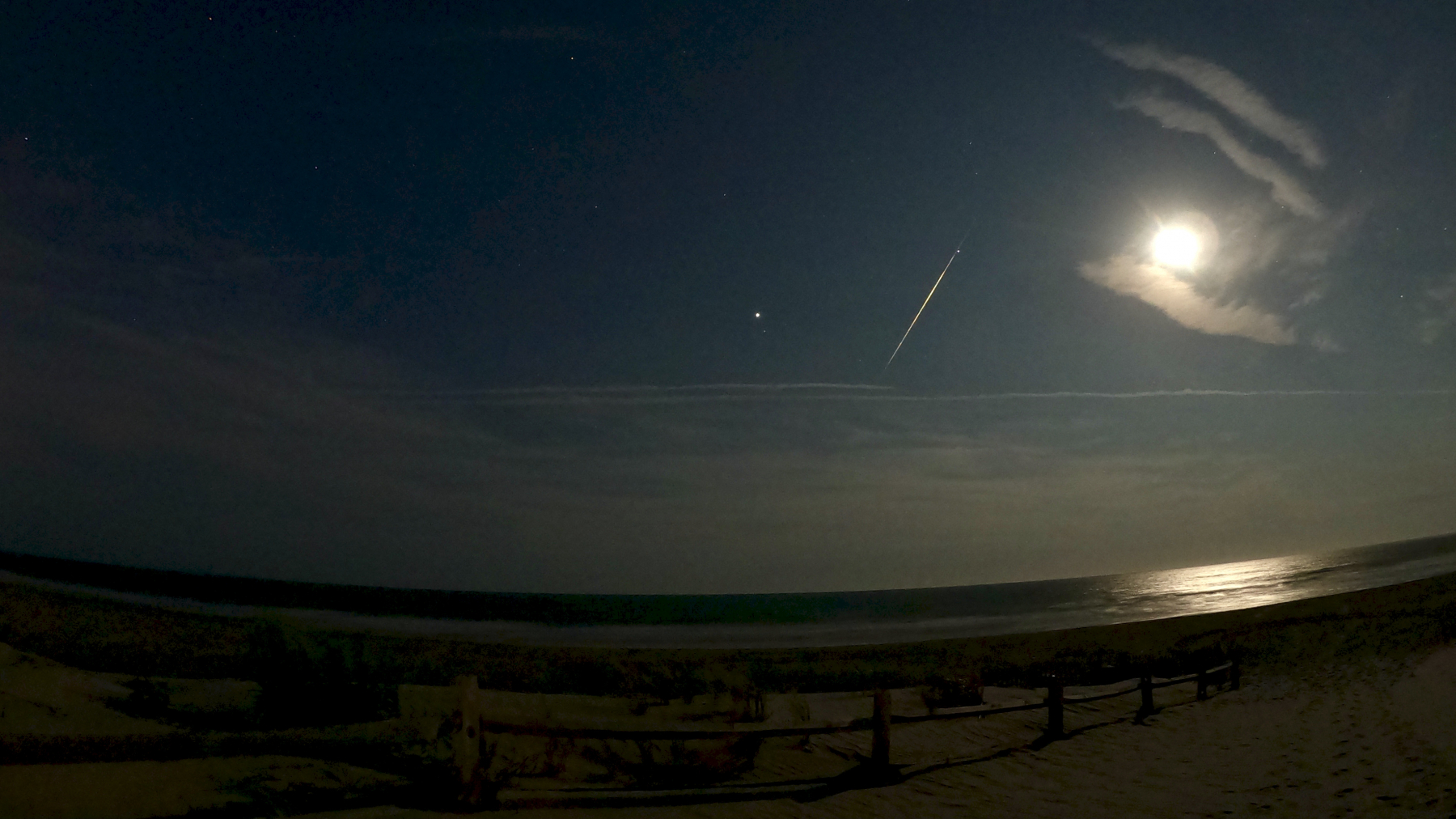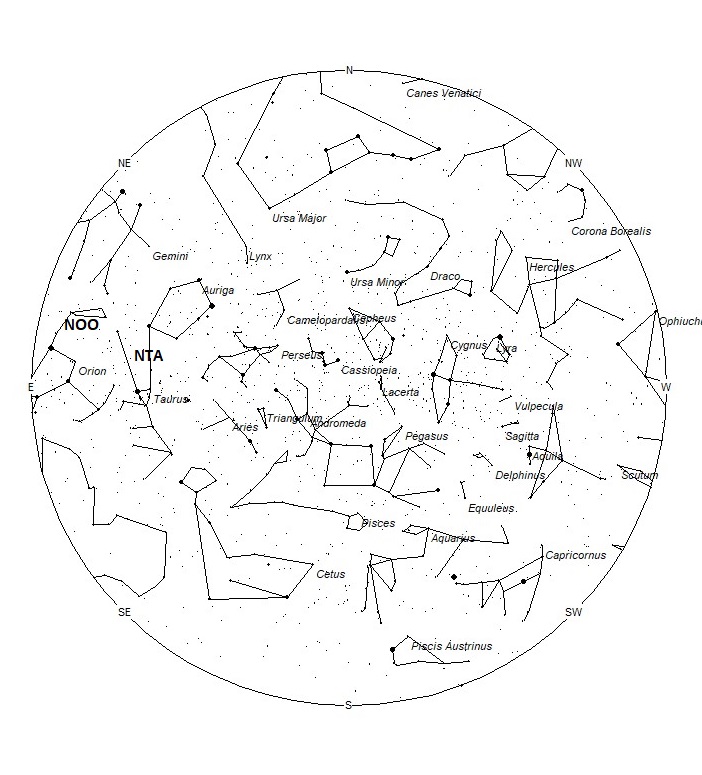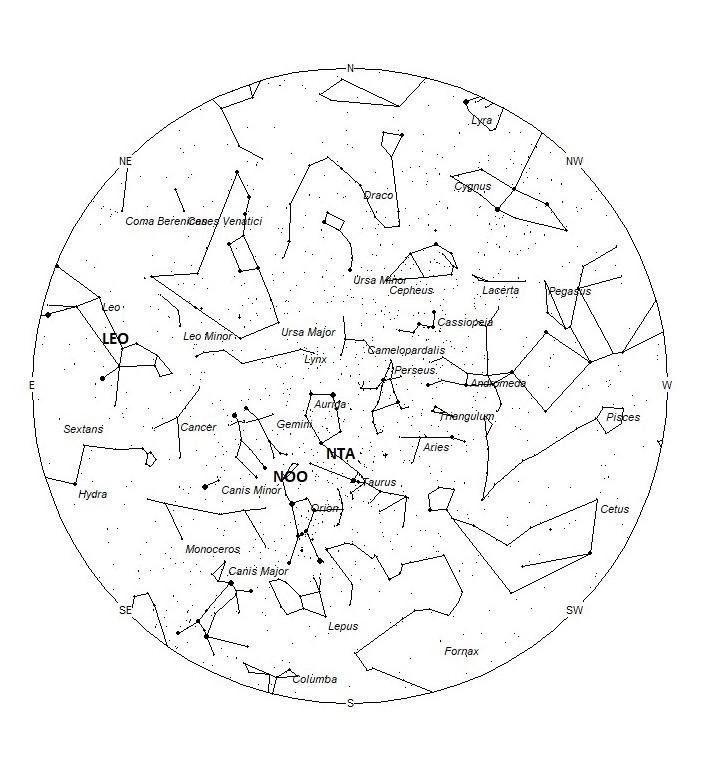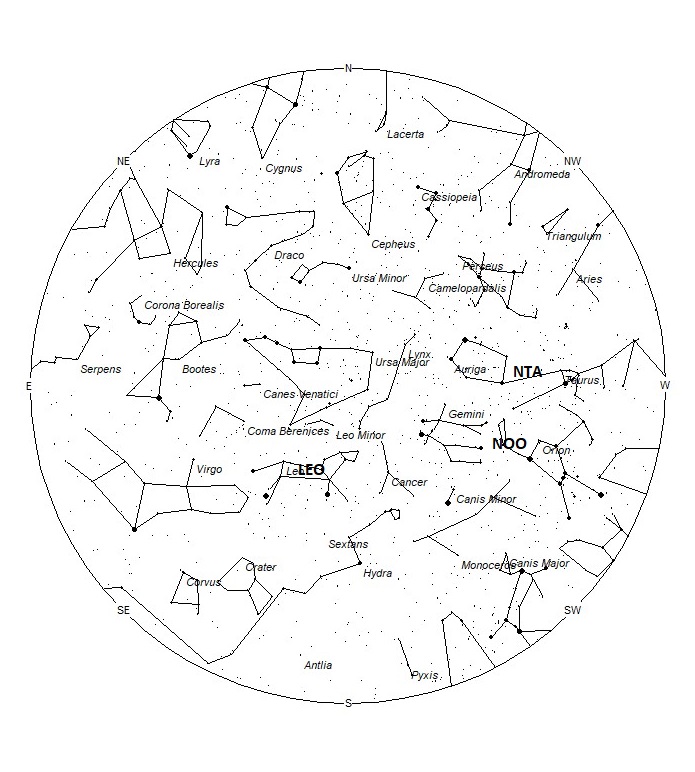
During this period, the moon reaches its last quarter phase on Saturday November 27. At that time the moon will rise near 23:00 (on Nov. 26). This weekend the morning sky will be bathed in moonlight from the half-illuminated moon. If your sky is transparent, successful meteor observations can be undertaken under such circumstances. It helps to face a direction opposite the moonlight in order to sustain your night vision. As the week progresses the moon becomes less of a nuisance as its phase wanes, and it rises later in the morning with each passing night. The estimated total hourly meteor rates for evening observers this week is near 4 as seen from mid-northern latitudes (45N) and 3 as seen from tropical southern locations (25S). For morning observers, the estimated total hourly rates should be near 15 as seen from mid-northern latitudes (45N) and 7 as seen from tropical southern locations (25S). The actual rates will also depend on factors such as personal light and motion perception, local weather conditions, alertness, and experience in watching meteor activity. Morning rates during this period are reduced due to moonlight. Note that the hourly rates listed below are estimates as viewed from dark sky sites away from urban light sources. Observers viewing from urban areas will see less activity as only the brighter meteors will be visible from such locations.
The radiant (the area of the sky where meteors appear to shoot from) positions and rates listed below are exact for Saturday night/Sunday morning November 27/28. These positions do not change greatly day to day so the listed coordinates may be used during this entire period. Most star atlases (available at science stores and planetariums) will provide maps with grid lines of the celestial coordinates so that you may find out exactly where these positions are located in the sky. I have also included charts of the sky that display the radiant positions for evening, midnight, and morning. The center of each chart is the sky directly overhead at the appropriate hour. These charts are oriented for facing south but can be used for any direction by rotating the charts to the desired direction. A planisphere or computer planetarium program is also useful in showing the sky at any time of night on any date of the year. Activity from each radiant is best seen when it is positioned highest in the sky, either due north or south along the meridian, depending on your latitude. It must be remembered that meteor activity is rarely seen at the radiant position. Rather they shoot outwards from the radiant, so it is best to center your field of view so that the radiant lies at the edge and not the center. Viewing there will allow you to easily trace the path of each meteor back to the radiant (if it is a shower member) or in another direction if it is sporadic. Meteor activity is not seen from radiants that are located far below the horizon. The positions below are listed in a west to east manner in order of right ascension (celestial longitude). The positions listed first are located further west therefore are accessible earlier in the night while those listed further down the list rise later in the night.
These sources of meteoric activity are expected to be active this week.
.
The December Phoenicids (PHO) are a periodic shower that rarely produces noticeable activity. The only impressive display produced so far by this shower occurred in 1956 when ZHR’s were near 100. The normal rage for these meteors is from November 28 through December 9 with a peak on December 2. The radiant at maximum is located at 00:52 (013) -52. This position lies in central Phoenix, 4 degrees southwest of the 3rd magnitude star known as beta Phoenicis. For those viewing from the northern tropics southward, this position also lies 7 degrees northwest of the bright 1st magnitude star known as Achernar (alpha Eridani). This area of the sky is best placed as soon as evening twilight ends. These meteors are best seen from the southern hemisphere where the radiant lies much higher in the sky. For those viewing from the northern hemisphere, only those in the northern tropics have any real chance of seeing activity from this source. At only 18 km/sec. the Phoenicids produce slow meteors.
The Northern Taurids (NTA) should be visible from a large radiant is located at 04:52 (73) +24. This area of the sky is located in northern Taurus, 3 degrees northeast of the 4th magnitude star known as tau Tauri Aa. This radiant is best placed near 0100 LST, when it lies on the meridian and is located highest in the sky. Rates at this time should be 1 per hour as seen from the Northern Hemisphere and less than 1 per as seen from south of the equator. With an entry velocity of 29 km/sec., the average NTA meteor would be of medium-slow velocity.
The November Orionids (NOO) are active from November 13 through December 6, with maximum activity occurring on November 28th. The radiant is currently located at 06:04 (091) +16. This area of the sky lies on the in northeastern Orion, 1 degree northwest of the 4th magnitude star known as nu Orionis. This radiant is best placed in the sky near 0200 LST, when it lies highest above the horizon. Rates should be near 2 per hour as seen from the Northern Hemisphere and 1 per hour as seen from south of the equator. With an entry velocity of 44 km/sec., most activity from this radiant would be of medium speed.
The Puppid-Velids (PUP) are a vast complex of weak radiants located in the constellations of Puppis and Vela. Visual plots and photographic studies have revealed many radiants in this area during November and December. The combined strength of these radiants can produce a ZHR of 10. Actual hourly rates will be much less unless you happen to be observing from the deep Southern Hemisphere. Activity from this source begins around December 1st. The center of this activity is currently located at 08:10 (122) -45. This position lies in western Vela, 2 degrees northeast of the 2nd magnitude star known as gamma Velorum. Peak rates occur near December 7. These meteors are best seen near 0300 LST when the radiant lies highest above the horizon in a dark sky. Observers located in the Southern Hemisphere have an advantage viewing this shower as the radiant will rise higher into their sky allowing more activity to be seen. Since the radiant lies low in the south for most northern hemisphere observers, meteors seen from north of the equator tend to be long in length and long-lasting. At 40 km/sec. the Puppid-Velids produce meteors of average velocity. Note: these are also listed as the “e Velids” from several sources.
The Leonids (LEO) are active from November 06-30 with maximum activity occurring on November 17th. The radiant is currently located at 10:32 (158) +19. This position lies in central Leo, 3 degrees east of the 2nd magnitude star known as Algieba (gamma Leonis A). The Leonid radiant is best placed during the last hour before morning twilight when the radiant lies highest in a dark sky. Leonids may be seen from the Southern Hemisphere, but the viewing conditions are not quite as favorable as those north of the equator. Current rates are expected to be less than 1 per hour no matter your location. With an entry velocity of 71 km/sec., most activity from this radiant would be of swift speed with numerous persistent trains on the brighter meteors.
As seen from the mid-northern hemisphere (45N) one would expect to see approximately 9 sporadic meteors per hour during the last hour before dawn as seen from rural observing sites. Evening rates would be near 3 per hour. As seen from the tropical southern latitudes (25S), morning rates would be near 7 per hour as seen from rural observing sites and 2 per hour during the evening hours. Locations between these two extremes would see activity between the listed figures. Evening rates are reduced by moonlight.
| SHOWER | DATE OF MAXIMUM ACTIVITY | CELESTIAL POSITION | ENTRY VELOCITY | CULMINATION | HOURLY RATE | CLASS |
| RA (RA in Deg.) DEC | Km/Sec | Local Standard Time | North-South | |||
| December Phoenicids (PHO) | Dec 02 | 00:52 (013) -52 | 18 | 21:00 | <1 – <1 | III |
| Northern Taurids (NTA) | Nov 12 | 04:52 (73) +24 | 29 | 01:00 | 1 – <1 | II |
| November Orionids (NOO) | Nov 30 | 06:04 (091) +16 | 44 | 02:00 | 2 – 1 | II |
| Puppid-Velids (PUP) | Dec 07 | 08:10 (122) -45 | 40 | 04:00 | <1 – <1 | II |
| Leonids (LEO) | Nov 17 | 10:32 (158) +19 | 71 | 06:00 | 1 – <1 | I |







 You saw something bright and fast? Like a huge shooting star? Report it: it may be a fireball.
You saw something bright and fast? Like a huge shooting star? Report it: it may be a fireball.  You counted meteors last night? Share your results with us!
You counted meteors last night? Share your results with us!  You took a photo of a meteor or fireball? You have a screenshot of your cam? Share it with us!
You took a photo of a meteor or fireball? You have a screenshot of your cam? Share it with us!  You caught a meteor or fireball on video? Share your video with us!
You caught a meteor or fireball on video? Share your video with us!